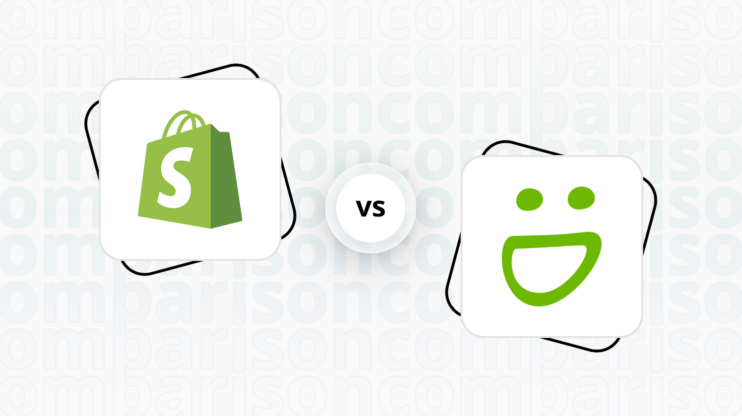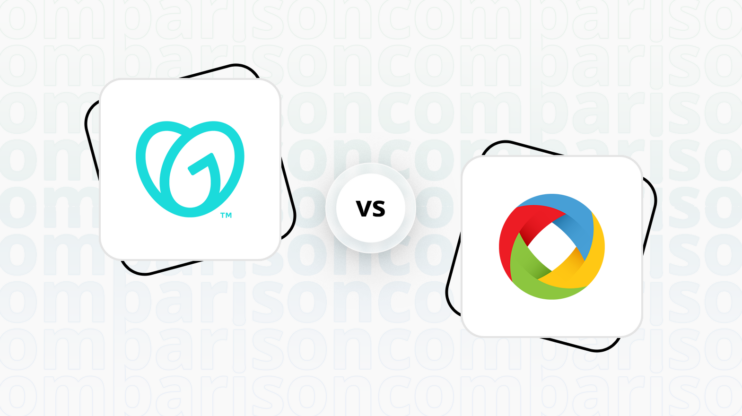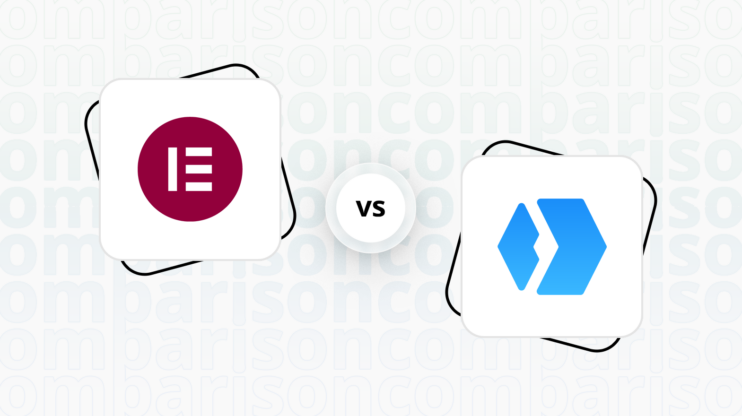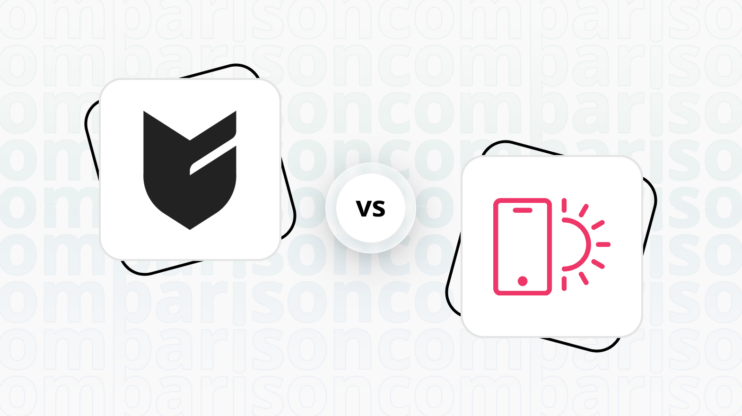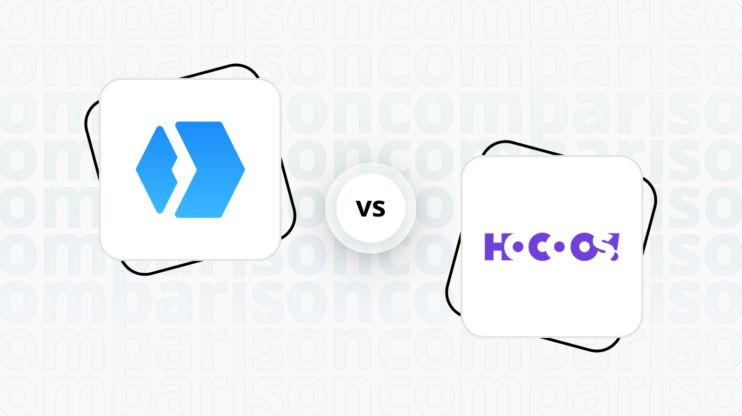Final verdict
Webflow and Webnode both offer unique strengths, catering to different user needs and preferences.
-
Webflow (Overall Grade: 7.9/10)
is a powerful platform designed for professional designers and developers. It excels in providing extensive design functionalities, a flexible CMS, and top-tier hosting services. Webflow is ideal for users who need advanced customization and are comfortable with a steeper learning curve. Its robust ecommerce features, comprehensive marketing tools, and superior customer support make it a strong choice for creating custom, responsive websites. -
Webnode (Overall Grade: 6.5/10)
is a user-friendly website builder that is perfect for beginners. It offers a drag-and-drop interface, making it easy to create and manage websites without any coding knowledge. Webnode is suitable for users looking for a quick and simple way to build a website. While it may lack some advanced features and customization options, its ease of use, affordability, and basic ecommerce capabilities make it a good option for small businesses and personal websites.

|

|
|
|---|---|---|
|
Design functionalities & templates |
8.6 |
7.1 |
|
Ease of use |
7.5 |
8.0 |
|
Ecommerce |
8.5 |
6.3 |
|
Website Editors |
9.0 |
7.3 |
|
Product testing options |
6.3 |
5.3 |
|
Price |
8.0 |
7.7 |
|
Hosting quality |
8.9 |
6.3 |
|
Website speed optimization |
8.1 |
6.1 |
|
Plugins and integrations |
5.5 |
6.8 |
|
Marketing features |
7.8 |
5.5 |
|
Customer support |
8.3 |
5.3 |
|
Security |
7.8 |
7.7 |
|
AI capabilities |
8.3 |
5.3 |
|
User Management |
8.3 |
6.9 |
Best for ecommerce
 8.5
8.5
 6.3
6.3
Verdict
: Webnode is suitable for beginners and small-scale operations, while Webflow excels in providing advanced ecommerce features and customization for professional designers and larger businesses.
-
Webflow
: Known for its powerful design tools and flexible CMS, Webflow is ideal for businesses looking for extensive customization and scalability. It offers comprehensive ecommerce features, including advanced product management, marketing tools, and integration with major payment gateways. When comparing Webflow vs Webnode, Webflow stands out for its robust capabilities and professional-grade design options. -
Webnode
: Its user-friendly drag-and-drop interface is perfect for those starting out. The platform offers basic ecommerce features suitable for small-scale online stores. However, it may fall short in terms of customization and scalability compared to Webflow. Webnode is a good option for beginners who want to create a simple ecommerce website quickly and easily.
Best for informational & business websites
 8.6
8.6
 7.2
7.2
Verdict
: Webflow is the superior choice for creating informational business websites, offering advanced design capabilities and robust hosting services. Webnode, while user-friendly and suitable for beginners, falls short in comparison to Webflow’s comprehensive feature set.
-
Webflow
: Webflow excels in providing a powerful design experience with a wide array of templates and customization options. Its platform is ideal for professional designers and businesses looking for a high degree of creative control. With a score of 8.6, Webflow’s advanced design tools, flexible CMS, and top-tier hosting services make it a comprehensive solution for creating custom, responsive websites. -
Webnode
: Webnode is a good option for beginners who want to create a simple website quickly and easily. It offers a user-friendly drag-and-drop interface and a variety of customizable templates. However, with a score of 7.2, Webnode lacks the advanced design capabilities and robust hosting services that Webflow provides. For those prioritizing ease of use over advanced functionality, Webnode is a suitable choice.
Detailed comparison
Design functionalities & templates
Design FunctionalitiesRepresents how well each platform allows for creative design and customization of websites.Score Components:
- Template Variety (30%): Range and quality of design templates.
- Customization (30%): Flexibility and options for design alterations.
- User Interface (20%): Ease and intuitiveness of the design process.
- Responsiveness (10%): Adaptability to different devices and screen sizes.
- Innovation (10%): Unique design features and tools.
 8.6
8.6
 7.1
7.1
🏆
Winner: Webflow.
If you’re looking for a platform that offers more creative control and a wide array of design features, Webflow is the preferred choice.
Webflow delivers a robust design experience with a diverse range of template and customization options. Boasting over 1000 pre-built templates covering various industries and website types, including free and premium options, Webflow ensures a constantly evolving library for users. Templates are categorized for easy browsing, considering industry, website type, style, and features. The design customization features include a visual drag-and-drop editor for real-time adjustments, fine-grained control over every aspect of the design, and the ability to inject custom code for advanced users seeking additional personalization and unique functionalities.
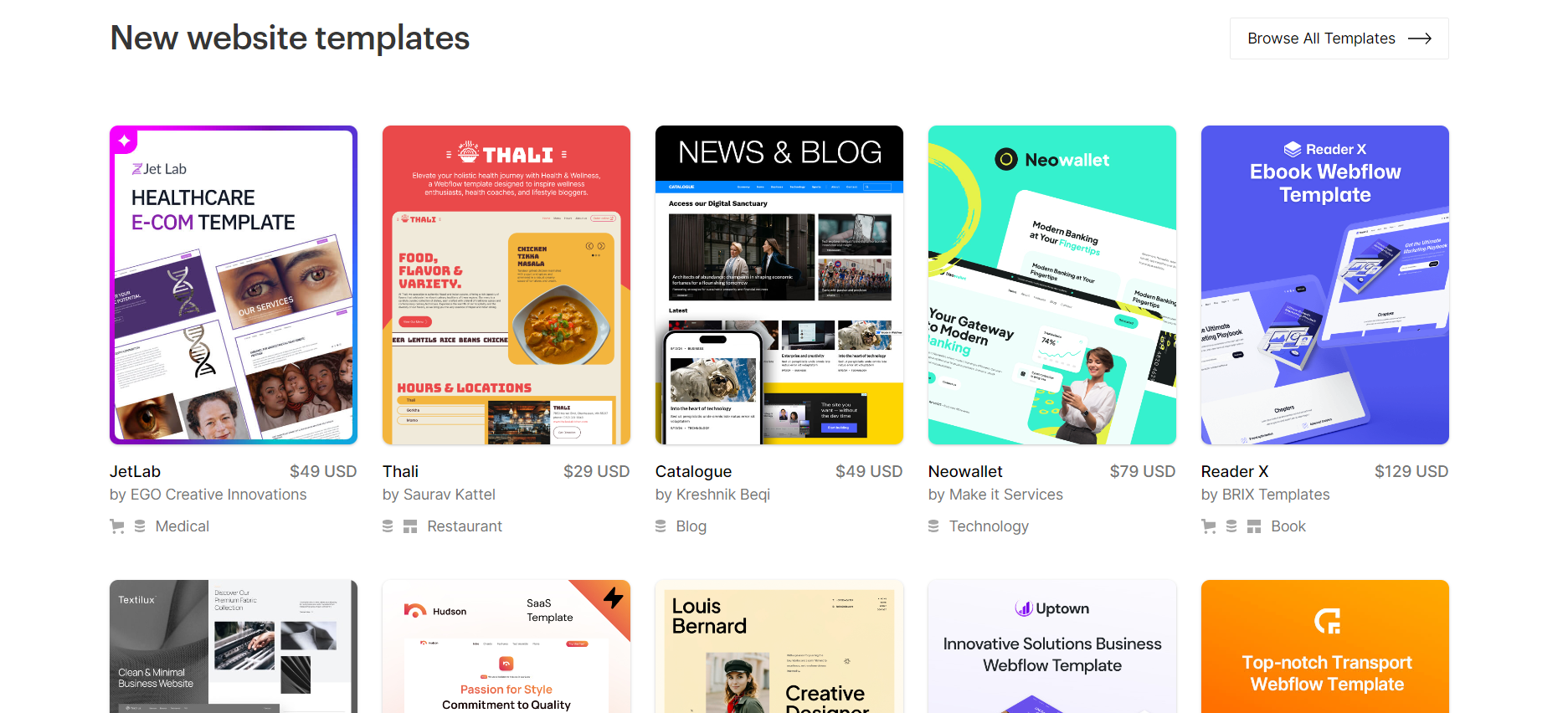
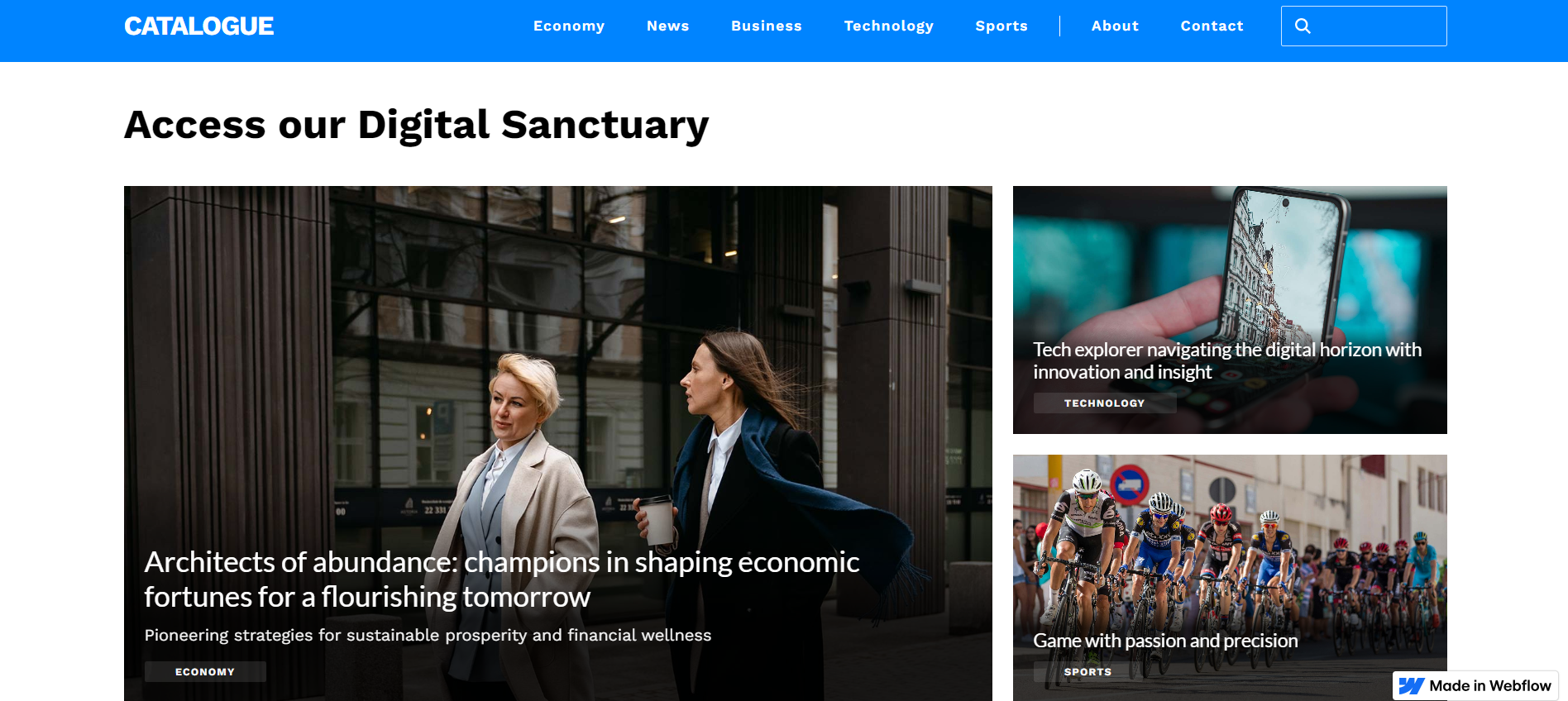
Compared to Webflow, Webnode offers a variety of website templates designed for different purposes, from business and portfolios to restaurants and travel. These templates are customizable and responsive, ensuring they display well on any device. While an exact number isn’t available, Webnode provides a wide selection to cater to diverse website needs.
Get a head start on website creation with AI
Create a custom website tailored to your business needs 10X faster with 10Web AI Website Builder!
Ease of use
Ease of useReflects the platform’s overall user-friendliness.Score
Components:
- Learning curve (40%): Quickness and ease of getting started.
- Interface design (30%): Simplicity and intuitiveness of layout.
- User guidance (20%): Quality of tutorials and support.
- Flexibility (10%): Adaptability to various user skills.
 7.5
7.5
 8.0
8.0
🏆 Winner: Webnode
. Scoring 8.0, Webnode is praised for its user-friendly website building platform, making it exceptionally easy for beginners to create and manage their websites. Webflow, with a score of 7.5, offers a robust platform but with a steeper learning curve, especially for those new to website design. If ease of use is a priority, Webnode is the clear winner in this category.
Learning Resources
🏆 Winner: Webflow
. While both platforms offer solid learning resources, Webflow goes a step further with its comprehensive set of learning resources and thriving community, making it easier for users to learn and adapt.
For ecommerce
EcommerceMeasures the platform’s effectiveness in supporting online business activities.Score Components:
- Ecommerce themes and templates (20%): Variety and design of templates.
- Product management (25%): Ease of managing and organizing products.
- Payment options (25%): Variety and convenience of payment methods.
- Ecommerce features (20%): Features for managing an ecommerce store.
- Integration (10%): Compatibility with external e-commerce tools and services.
 8.5
8.5
 6.3
6.3
Webflow and Webnode both offer ecommerce capabilities, but they cater to different needs. Webflow is a robust platform for creating online stores, offering comprehensive ecommerce features such as easy store creation without coding, extensive customization options, product management with variations, inventory tracking, integration with major payment gateways, automated shipping calculations, tax configuration, and marketing tools like abandoned cart recovery and email marketing. On the other hand, Webnode’s e-commerce features include an online store builder, product management tools, various payment options, and basic analytics. However, users may find its customization options limited compared to other platforms, and transaction fees could impact profitability. Integration capabilities may also be constrained, and scalability might be a concern for larger businesses.

|

|
|
|---|---|---|
|
Ecommerce themes and templates |
7.5 |
6.5 |
|
Product page customization |
8.3 |
7.0 |
|
Payment processing and commissions |
7.8 |
6.8 |
|
POS capabilities |
6.5 |
4.0 |
|
Payment gateways |
8.0 |
7.0 |
|
Product numbers |
7.0 |
5.5 |
|
Additional ecommerce features |
7.9 |
6.0 |
Webflow ecommerce features:
- Checkout and Payment Processing with Stripe, PayPal, etc.
- Marketing and Promotions
- Tax and Shipping calculations
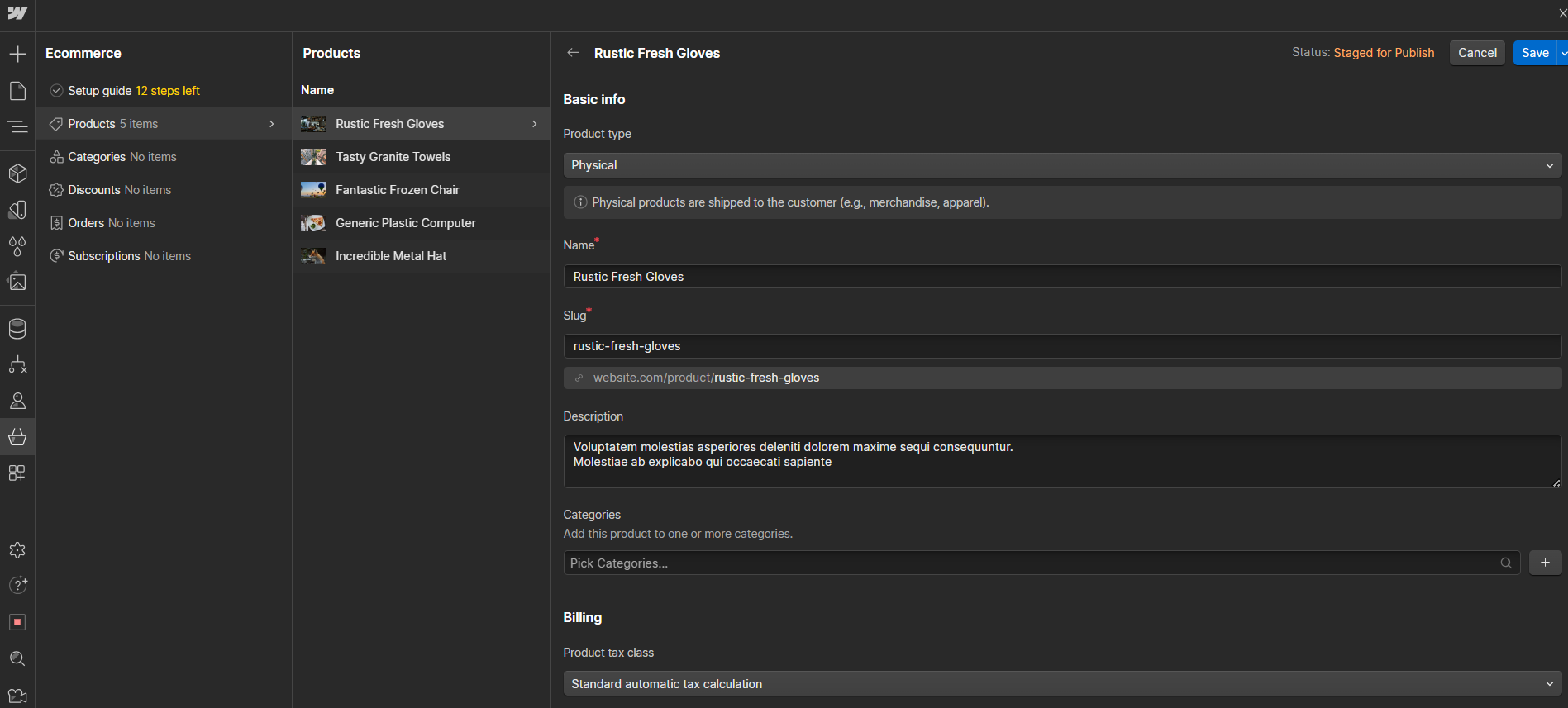
Webnode ecommerce features:
- Shipping options
- Payment gateway integrations
- Order management
- Coupons and discounts
Ecommerce themes & templates
Webflow offers a diverse range of ecommerce themes and templates designed to cater to various types of online stores, from fashion and technology to artisan crafts and children’s products. Each template comes equipped with built-in ecommerce functionality, allowing you to easily add products and manage your store without the need for coding. In contrast, Webnode offers ecommerce-specific templates designed for creating online stores, though the exact number of templates available may vary over time. These templates typically come with features such as product showcasing, shopping cart functionality, support for various payment gateways, and customization options. However, users should be mindful of potential limitations such as customization restrictions, feature limitations based on plan tiers, transaction fees, and integration limitations when choosing a template and plan for their ecommerce website on Webnode.
Product page customization
Webflow offers extensive customization options for eCommerce product pages, allowing users to design and personalize their pages without coding. It provides tutorials for creating product pages from scratch, offers responsive templates for various devices, and allows users to add custom code and dynamic content using Webflow’s CMS for maximum customization flexibility. On the other hand, Webnode provides users with extensive customization options for product pages, allowing for the creation of visually appealing and informative displays. Through customizable content blocks, product images and galleries, and tailored product descriptions, users can effectively showcase their products. Additionally, features such as customizable call-to-action buttons, product variations, and SEO optimization contribute to a seamless and optimized shopping experience.
Payment processing
When it comes to payment processing, Webflow provides a flexible and secure platform for payment processing and ecommerce through integrations with leading payment gateways like Stripe and PayPal. This allows users to accept a wide range of payments, including credit card transactions directly from their websites. Given the versatility of Stripe and PayPal, businesses can manage online sales efficiently, and these integrations likely support various transaction types, potentially including POS transactions for physical sales environments. In contrast, Webnode website builder supports various payment gateways, including popular options like PayPal and Stripe, for online transactions. While Webnode itself doesn’t charge commissions on transactions, payment gateways may have their own fee structures. Webnode primarily focuses on facilitating online transactions and doesn’t provide native POS capabilities, although integration with third-party POS solutions may be possible. For the latest information on supported payment gateways, transaction fees, and POS integrations, users should refer to Webnode’s official documentation or contact their customer support.
Website Editors
Website EditorsEvaluates the platforms’ website building and editing capabilities.Score Components:
- Customization tools (40%): Range and power of editing features.
- Editor usability (30%): User experience within the editor.
- Design flexibility (20%): Freedom in layout and design changes.
- Update and maintenance ease (10%): Simplicity of updating and maintaining the site.
 9.0
9.0
 7.3
7.3
🏆
Winner: Webflow
. With a score of 9.0, Webflow’s editor is praised for its intuitive visual interface that simplifies the process of designing and editing responsive websites without requiring deep technical knowledge. It offers a perfect blend of ease of use for beginners and the flexibility for more advanced users, enabling significant cost savings by allowing users to customize and manage their sites without hiring professionals.
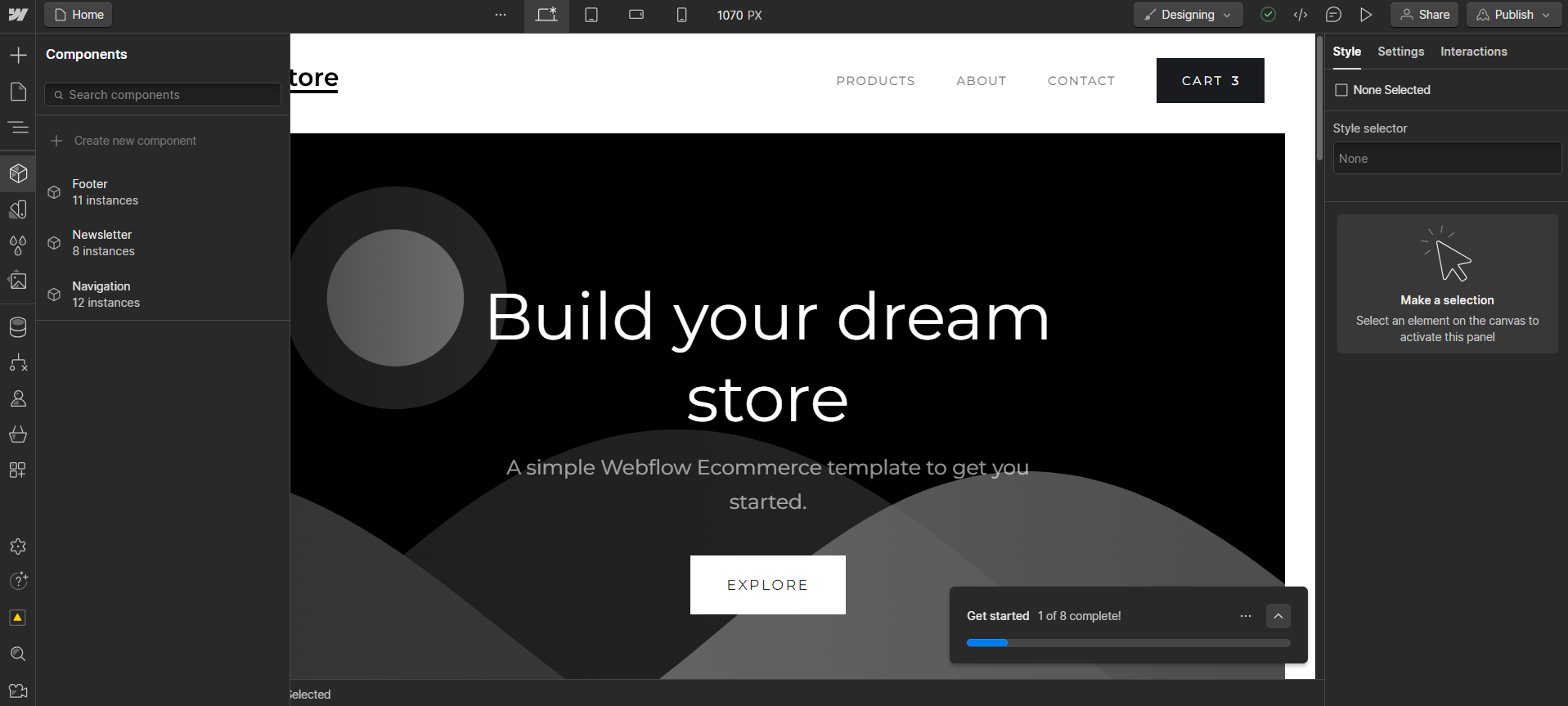
Webnode’s editor, scoring 7.3, features a user-friendly drag-and-drop interface with customizable templates, enabling users to easily create professional-looking websites without coding skills. The editor offers responsive design capabilities and multilingual support, catering to diverse audiences across different devices and languages.
Mobile editor/app
 7.0
7.0
 5.5
5.5

🏆
Winner: Webflow
. Both Webflow and Webnode do not have an official mobile editor app. However, Webflow has a third-party app called EditFlow, created by a community member for Webflow users. Currently, the app is only available for iOS. This gives Webflow an edge over Webnode, which allows users to edit their website using the mobile browser version of the editor, but it comes with certain limitations.
Therefore, Webflow is the winner in this category due to the availability of a third-party mobile editing app.
Product testing options
Product Testing OptionsAssesses the options for trying out platform features before commitment.Score Components:
- Trial quality (40%): Extent and usefulness of the trial or free version.
- Feature accessibility (30%): How many features are available to test.
- Trial duration (20%): Length of the trial period.
- Ease of transition (10%): Smoothness of moving from trial to paid plans.
 6.3
6.3
 5.3
5.3
Overall Result
:
Webflow wins
. Webflow scores 6.3 in product testing options, slightly higher than Webnode’s 5.3. Both Webflow and Webnode offer free versions that allow users to test some basic features. However, neither of them provides a trial version. Webnode stands out by offering a 15-day money back guarantee, which Webflow does not provide.

|

|
|
|---|---|---|
|
Free Plan |
Yes | Yes |
|
Trial Duration |
No | No |
|
Testing Premium Features |
Some features with free plan | Some features with free plan |
|
Money Back Guarantee |
No |
15-day money back guarantee |
Price
PriceLooks at the cost-effectiveness and value for money of each platform.Score Components:
- Plan value (40%): What each pricing tier offers.
- Transparency and clarity (30%): Clearness of pricing structures.
- Flexibility of plans (20%): Range of options to suit different budgets.
- Hidden costs (10%): Additional expenses not included in the plan.
 8.0
8.0
 7.7
7.7
Webflow and Webnode offer a range of pricing options, with Webflow scoring slightly higher in terms of price.
Webflow offers more flexibility with a free plan and custom pricing for enterprise solutions, while Webnode offers straightforward pricing with a range of features. Both offer discounts for annual billing.

|

|
|
|---|---|---|
|
Free |
Starter (Free): Limited features for new sites, including 2 static pages and 50 form submissions lifetime. |
No offering at this amount. |
|
$0-$10 |
No offering at this amount. |
LIMITED ($5.50/month): Basic plan, 200 MB storage, attach domain, website statistics, up to 5 form fields, last 30 days backup. This plan allows to manage 1 website with unlimited number of pages. Value for price: 3.0 |
|
$10-$20 |
No offering at this amount. |
MINI ($10.00/month): All essentials for a simple website, 1 GB storage, 3 GB bandwidth, website statistics, 1 email account. This plan allows to manage 1 website with unlimited number of pages. Value for price: 4.5 |
|
$20-$30 |
Basic ($18/month): Suitable for simple sites with a custom domain, including basic SEO controls and 500 monthly form submissions. And 100 pages. Value for price: 6.5 |
STANDARD ($16.90/month): For starting an online store, 3 GB storage, 10 GB bandwidth, 20 email accounts, basic store features. This plan allows to manage 1 website with unlimited number of pages. Value for price: 6.0 |
|
$30-$45 |
CMS ($29/month): For content-driven sites with 2,000 CMS items, 1,000 monthly form submissions, and full API access. And 150 website pages. Value for price: 7.5 |
PROFI ($26.50/month): Professional websites, 7 GB storage, unlimited bandwidth, 100 email accounts, full online store capabilities. This plan allows to manage 1 website with unlimited number of pages. Value for price: 7.5 |
|
$45-$50 |
Standard ($42/month): For new businesses with up to 500 ecommerce items, includes basic ecommerce features, and 2% transaction fee Value for price: 8.5 |
BUSINESS ($34.90/month): Comprehensive e-commerce, 15 GB storage, unlimited bandwidth, 1000 email accounts, advanced online store features. This plan allows to manage 1 website with unlimited number of pages. Value for price: 8.5 |
|
$80-$90 |
Business ($49/month): High traffic capacity, advanced features like site search, and up to 10 content editors. Value for price: 8.0 |
No offering at this amount. |
|
$200+ |
Plus ($84/month): Higher volume businesses with 0% transaction fees, up to 5,000 ecommerce items, and advanced features. Value for price: 9.0 |
No offering at this amount. |
location. As a result in rare cases the prices displayed here can differ from the ones you see on their
websites.
Hosting quality
Hosting
qualityExamines the reliability and performance of the hosting solutions.Score Components:
- Uptime (40%): Consistency and reliability of website availability.
- Speed (30%): Loading times and performance.
- Bandwidth and storage (20%): Sufficiency of resources provided.
- Data centers (10%): Quality and distribution of hosting infrastructure.
 8.9
8.9
 6.3
6.3
Winner: Webflow
. Webflow offers managed hosting with a 99.99% uptime and a guarantee on their Enterprise plan. They leverage a globally distributed network of data centers from Amazon Web Services (AWS) and Fastly. Webnode, on the other hand, does not disclose its hosting type or the locations of its data centers, and it does not offer an uptime guarantee. This lack of transparency and guarantee gives Webflow the edge in this category.

|

|
|
|---|---|---|
|
Do they offer hosting? |
Yes, included in all paid plans |
Yes, included in all paid plans |
|
Data Centers: |
Webflow doesn’t actually have its own data centers. Instead, it relies on a globally distributed network of data centers from Amazon Web Services (AWS) and Fastly. |
Webnode does not disclose the locations of its data centers |
|
Type of hosting: |
Managed Hosting |
Webnode does not disclose its hosting type |
|
Uptime: |
99.99% |
99.6% |
|
Uptime Guarantee: |
Only Enterprise plan, 99.99% |
No |
Website Speed Optimization
Website Speed OptimizationEvaluates optimization of website loading timesScore Components:
- PageSpeed Score (30%): Google’s score indicating performance optimization.
- Loading Time (30%): The average time until a website is fully interactive.
- Mobile Optimization (15%): Optimization effectiveness for mobile devices.
- Resource Optimization (15%): Optimizing images, scripts, and other heavy resources.
- CDN Usage (10%): Use of CDN to enhance speed across geolocations.
 8.1
8.1
 6.1
6.1
🏆 Winner: Webflow
Both Webflow and Webnode have strategies for speed optimization, but Webflow provides more detailed information and has a higher website speed optimization score.

|

|
|
|---|---|---|
|
Focus |
Custom Cache Settings, Custom Element Lazy Loading, Automatic Minification, Responsive templates, CDN |
Code Minification, Image Optimization, Caching |
|
Performance Tools |
Google Lighthouse, PageSpeed Insights |
Google PageSpeed Insights |
|
Key Strategies |
Custom Cache Settings, Custom Element Lazy Loading, Automatic Minification, Responsive templates, CDN |
Code Minification, Image Optimization, Caching |
|
Load Times |
Below 2 seconds average |
Varies depending on optimization |
|
Page Speed Scores Range |
77.2/100 |
Varies depending on optimization |
|
Core Web Vitals Improvement |
Improving components’ usability, and emphasis on LCP, FID and CLS |
No information provided |
Webflow’s approach to enhancing site speed includes custom cache settings, custom element lazy loading, automatic minification, responsive templates, and CDN. It has an average load time of below 2 seconds and a PageSpeed score of 77.2/100. Webflow also focuses on improving components’ usability and emphasizes on LCP, FID, and CLS for Core Web Vital improvements.
On the other hand, Webnode’s strategies for speed optimization include code minification, image optimization, and caching. However, its load times and PageSpeed scores vary depending on optimization, and it does not provide any information on their Core Web Vitals improvements. Therefore, Webflow is the winner in this comparison.
Get a head start on website creation with AI
Create a custom website tailored to your business needs 10X faster with 10Web AI Website Builder!
Plugins and integrations
Plugins and integrationsMeasures the range and effectiveness of additional plugins and integrations.Score Components:
- Variety of options (40%): Range of available add-ons.
- Integration smoothness (30%): Ease of integrating plugins into the site.
- Quality of plugins (20%): Functionality and reliability of the options.
- Custom integration capabilities (10%): Support for custom or third-party integrations.
 5.5
5.5
 6.8
6.8
🏆 Winner: Webnode.
With a score of 6.8, Webnode takes the lead over Webflow, which scores 5.5. Webnode supports a variety of plugins/integrations developed by Elfsight, aiming to enhance website functionality, improve user engagement, and drive conversions. These plugins cover a wide range of applications including social media, reviews, e-commerce, chats, and forms.
On the other hand, Webflow doesn’t have plugins or extensions in the traditional sense. Instead, it offers a built-in library of website elements and functionalities that you can use to create your website. This library is constantly being expanded, so you’ll always have access to the latest features and tools. However, Webflow does integrate with a number of third-party services and tools that can add even more functionality to your website. These integrations are not managed by Webflow, so the number of available options and their pricing structures can vary depending on the specific tools you choose.
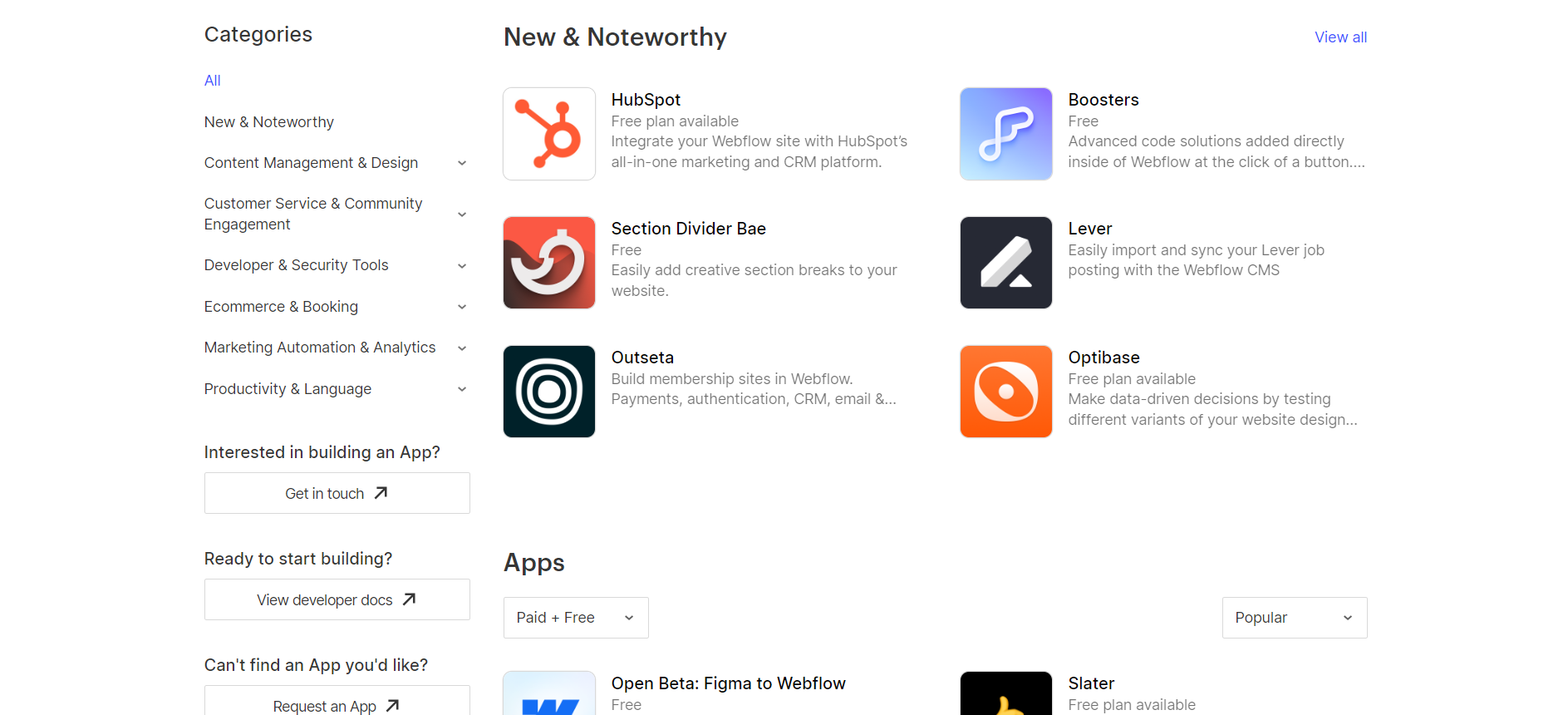

Marketing Features
Design FunctionalitiesRepresents how well each platform allows for creative design and customization of websites.Score Components:
- Template Variety (30%): Range and quality of design templates.
- Customization (30%): Flexibility and options for design alterations.
- User Interface (20%): Ease and intuitiveness of the design process.
- Responsiveness (10%): Adaptability to different devices and screen sizes.
- Innovation (10%): Unique design features and tools.
 7.8
7.8
 5.5
5.5
🏆
Overall Winner: Webflow
. Webflow stands out for its comprehensive marketing tools, especially in analytics and ad campaign management. Webnode, while offering a range of marketing features, lacks in-depth analytics and reporting capabilities.

|

|
|
|---|---|---|
|
SEO Tools |
|
|
|
Email Marketing |
|
|
|
Blogging |
|
|
|
Social Media Integration |
Simplifies content sharing and audience engagement on major social platforms |
Yes, through third party integration |
|
Analytics and Reporting |
Integrates with Google Analytics for comprehensive web traffic and behavior analysis |
Yes, but lacks in-depth analytics and reporting capabilities |
|
Ads and Promotions |
Supports ad and promotion management through integration with platforms like Google Optimize |
Yes, but lacks advanced ad management and promotion features |
Customer Support
Customer supportEvaluates the quality and availability of support options.Score Components:
- Response time (40%): Speed of support responses.
- Support quality (30%): Effectiveness and helpfulness of the support.
- Availability (20%): Range of support channels (phone, chat, email).
- Resource richness (10%): Quality of self-help and educational materials.
 8.3
8.3
 5.3
5.3
🏆 Winner: Webflow
. In the Webflow vs Webnode comparison, Webflow stands out with its comprehensive 24/7 customer support through live chat, email, and community forums. Webflow also offers extensive documentation and video tutorials, making it easier for users to find solutions to their problems. For enterprise users, Webflow provides a dedicated Customer Success Manager and priority support, ensuring that large organizations receive the assistance they need.
Webnode, on the other hand, offers customer support in more than 20 languages and aims to resolve inquiries within 24 hours. However, its support is limited to weekdays, and live chat or phone support is not generally available. Premium customers do receive priority phone support, but this is not as extensive as the support options provided by Webflow. Overall, Webnode’s support is more suited for beginners and smaller websites, whereas Webflow offers a more robust support system for all user levels.
Security
SecurityLooks at the platforms’ security measures and data protection.Score Components:
- Data protection (40%): Safeguards for user and customer data.
- SSL and encryption (30%): Implementation of secure connections.
- Compliance (20%): Adherence to industry security standards.
- Regular updates (10%): Frequency of security updates and patches.
 7.8
7.8
 7.7
7.7
🏆
Winner: Webflow
. Webflow takes the lead in security with a score of 7.8, slightly higher than Webnode’s 7.7. Webflow’s commitment to data privacy and security is evident in their robust encryption techniques, strict access controls, and regular system updates and audits. They also offer SSL encryption for secure data transmission and two-factor authentication for added security.
Webnode, on the other hand, also offers a variety of security measures, including HTTPS for all sites, GDPR compliance tools, and a Premium Site Security add-on with IP Filters, Form Protection, and Malware Scanning for premium users. However, it falls slightly short in comparison to Webflow’s comprehensive security measures.
AI Capabilities
AI capabilitiesMeasures the effectiveness of AI-driven features and tools.Score Components:
- Automation efficiency (40%): Impact of AI on streamlining processes.
- Personalization (30%): AI-driven customization for users or customers.
- AI-Assisted design (20%): Role of AI in website design and functionality.
- Data analysis (10%): Use of AI in interpreting user data and analytics.
 8.3
8.3
 5.3
5.3

|

|
|
|---|---|---|
|
AI Builder |
Not available, but announced for future release |
Available, streamlines website creation process |
|
AI Ecommerce Features |
Not available |
Not available |
|
AI Content Generation |
Not available, but announced for future release |
Not available |
|
Additional AI Features |
Smart suggestions for design elements and layouts announced for future release |
None apart from AI builder |
🏆 Winner: Webnode
. Webnode, with a score of 5.3, currently offers an AI builder that simplifies the website creation process, making it more accessible and efficient for users regardless of their technical expertise.
Webflow, with a score of 8.3, does not currently have AI capabilities but has announced plans to introduce them in the future. These include an AI builder, AI content generation, and additional AI features such as smart suggestions for design elements and layouts, and AI-powered content management capabilities. While these features are promising, they are not currently available, giving Webnode the edge in this category.
User Management
User ManagementAssesses the platforms’ capabilities in managing user roles, permissions, and accessibility.Score Components:
- Role Customization (40%): Flexibility in creating and defining user roles and
permissions. - Ease of Management (30%): User interface and tools for managing users.
- Access Control (20%): Effectiveness of access control measures for different user
levels. - Scalability (10%): Ability to manage a growing number of users efficiently.
 8.3
8.3
 6.9
6.9
🏆 Winner: Webflow
. Both Webflow and Webnode offer user management features, but Webflow’s approach is more comprehensive and flexible.
- Webflow’s user management varies by plan, with Core, Growth, and Enterprise plans offering unlimited editors. Access levels include Designer for full access and Editor for content editing. Workspace roles like Admin, Designer, and Editor ensure collaboration and security.
- Webnode allows multiple users to manage and edit a website, but the exact number varies depending on the subscription plan. The free version provides limited user access, while premium plans offer more flexibility, including the ability to add multiple users with different roles and permissions.
Webflow User Roles and Access Levels:
| Role | Description | Access Highlights |
|---|---|---|
| Workspace Owner | Full control over Workspace settings and member management. | Edit settings, manage billing, access/edit all sites, invite/remove members, manage permissions. |
| Workspace Admin | Similar to the owner with some restrictions. | Edit settings, manage billing, access/edit all sites, invite/remove members (except owner), manage permissions. |
| Workspace Member | Limited control focused on site interaction. | Download invoices, access/edit sites, invite members. |
| Workspace Guest | Temporary collaborators with limited access. | Access/edit sites. |
| Workspace Commenter | Limited to commenting for feedback on sites. | Create/view/resolve comments, preview sites. |
| Site Admin | Full control at the site level. | Manage permissions, delete/transfer sites, billing management, design and publish changes. |
| Can Design | Design capabilities with some restrictions on publishing. | Design in Designer, create/modify classes and components, publish changes with permission. |
| Can Design (Limited) | Restricted design capabilities for Enterprise customers. | Create new classes, modify created classes, limited publishing capabilities. |
| Can Edit | Content editing without full design privileges. | Edit text/links/images, manage assets, publish Collection items and Ecommerce products. |
| Can Comment (Site Level) | Commenting for feedback at the site level. | Create/view/resolve comments, preview sites. |
Webnode User Roles and Access Levels:
| Role | Description | Access Highlights |
|---|---|---|
| Website Owner | The individual or entity that owns the Webnode website. | Full access: can modify site structure, design, content, and manage user roles. |
| Administrator | Users with administrative privileges assigned by the website owner. | Nearly full access, including content management, and some settings adjustments. |
| Editor | Users tasked with creating, editing, and publishing content. | Access to add and edit content, blog posts, and pages, but cannot alter design. |
| Contributor | Users who can contribute content but cannot publish it. | Can draft content but need approval from an Editor or Administrator to publish. |
| Viewer/Visitor | Individuals who visit the website without any editing permissions. | Can view the public website and interact through comments or contact forms. |
| E-commerce Manager | Specifically for websites with an e-commerce component, managing products. | Can add, edit, and manage products, orders, and customer interactions. |
Additional Features

|

|
|
|---|---|---|
|
SSL Certificate |
|
|
|
Custom Domain |
|
|
|
Free Custom Domain Included |
|
|
|
International Domains |
|
|
|
Mobile Responsive |
|
|
|
Page Speed |
|
|
|
Website Builder Mobile App |
|
|
|
Convert a Website To An App |
|
|
|
Website Analytics |
|
|
|
Multilingual Sites |
|
|
|
Multiple Users |
|
|
User Feedback
Webflow receives high praise for its user-friendly interface, eliminating the need for coding while offering extensive design flexibility. Users appreciate its scalability, cost-effectiveness, and seamless integration of essential features like forms and CMS. However, some users note a slight learning curve and occasional limitations, particularly in ecommerce functionalities and content management. Overall, Webflow proves to be a powerful tool for building and managing websites, offering robust features for both beginners and experienced developers, albeit with some room for improvement in certain areas like collaborative editing and content management.
User feedback on Webnode highlights its ease of use, rapid website creation capabilities, and the wide range of templates available, making it a popular choice for individuals and businesses seeking an intuitive web development platform. While praised for its user-friendly interface and quick setup, including domain purchase and application, some users express a desire for more flexibility and customization options, especially in themes and e-commerce features. Comparatively, it falls short on advanced functionalities such as SEO tools and widgets offered by competitors like WordPress. Customer service experiences vary, with some users facing challenges in getting support for email hosting and analytics integration. Overall, Webnode is celebrated for its ability to accommodate users with little to no coding knowledge, offering an accessible solution for creating professional websites, though it may not fully meet the needs of those requiring more complex site features or dedicated customer support.
The making of this blog
We followed a clear, step-by-step process to write and research this article.
FAQ
Which platform is better for professional designers, Webflow or Webnode?
Can beginners easily build a website with Webnode?
How do Webflow and Webnode compare in terms of ecommerce capabilities?
Which platform offers better customer support, Webflow or Webnode?
Are there any AI capabilities available in Webflow or Webnode?
Which platform is more secure, Webflow or Webnode?
Can I manage multiple users on both Webflow and Webnode?










